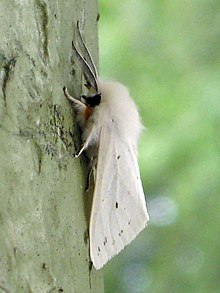| Fall webworm | |
|---|---|

| |
| Scientific classification | |
| Domain: | Eukaryota |
| Kingdom: | Animalia |
| Phylum: | Arthropoda |
| Class: | Insecta |
| Order: | Lepidoptera |
| Superfamily: | Noctuoidea |
| Family: | Erebidae |
| Subfamily: | Arctiinae |
| Genus: | Hyphantria |
| Species: | H. cunea
|
| Binomial name | |
| Hyphantria cunea (Drury, 1773)
| |
| Synonyms | |
| |
The fall webworm (Hyphantria cunea) is a moth in the family Erebidae known principally for its larval stage, which creates the characteristic webbed nests on the tree limbs of a wide variety of hardwoods in the late summer and fall. It is considered a pest but does not harm otherwise healthy trees. It is well known to commercial tree services and arboriculturists. Fall webworms are an invasive species in East Asia.[1]
- ^ Edosa, Tariku T.; Jo, Yong H.; Keshavarz, Maryam; Anh, Young Sang; Noh, Mi Young; Han, Yeon S. (February 2019). "Current status of the management of fall webworm, Hyphantria cunea : Towards the integrated pest management development". Journal of Applied Entomology. 143 (1–2): 1–10. doi:10.1111/jen.12562. S2CID 92540632.